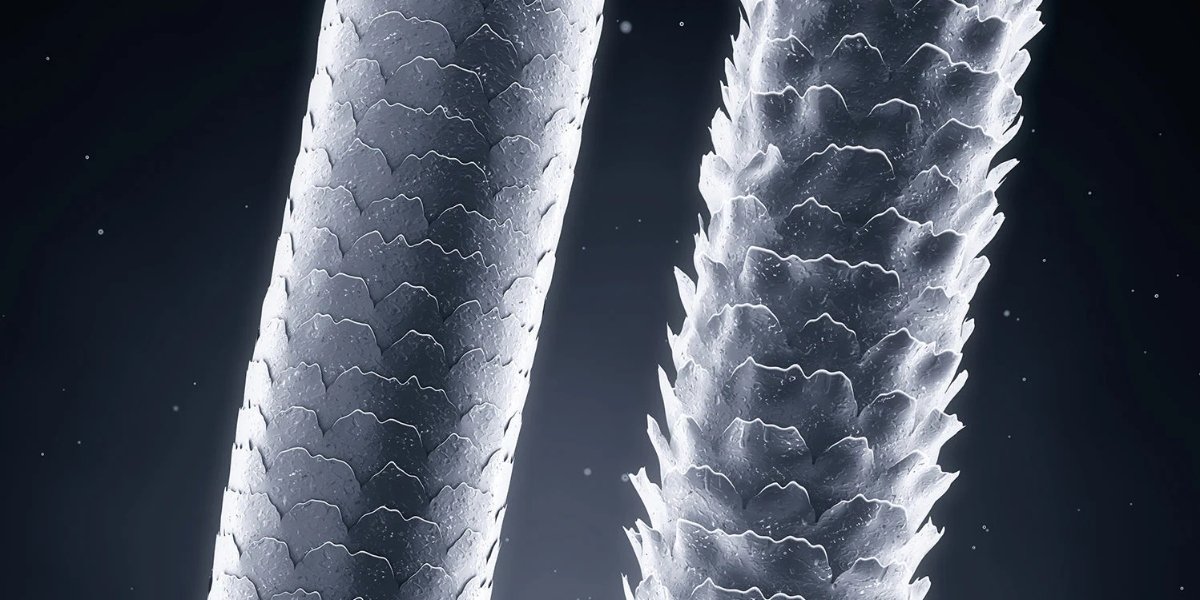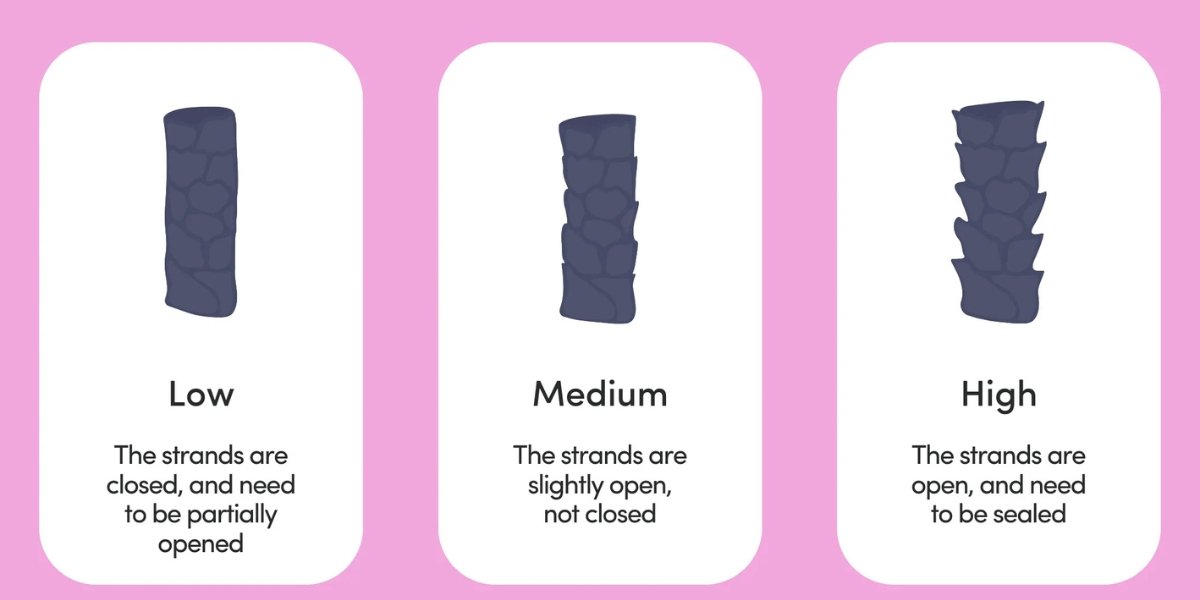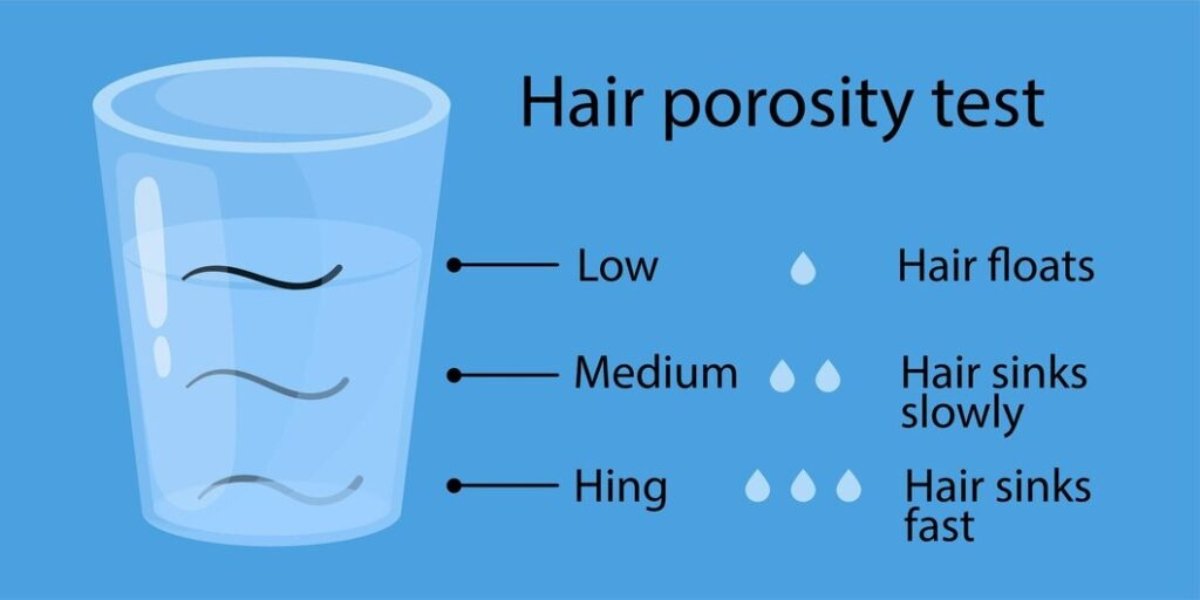Blog
How to Check Hair Porosity for Healthy Hair Care

Does your hair take a long time to dry with products often sitting on the surface, leading to product buildup? Or do you find your hair feels dry and brittle with water not absorbing? Chances are you have low-porosity hair. The good news is with the right hair products and hair care routine, you can help your hair to retain moisture and bring balance back into the hair shafts. In this blog, we will do a deep dive into what hair porosity is, how to test hair porosity as well as the steps you can take to combat low hair porosity.
What is Hair Porosity?
Hair porosity is marked by the hair shaft’s ability to absorb and retain moisture. As a result, your hair will react differently to products and you will need a specific hair care routine to combat dryness.
Types Of Hair Porosity
To determine your hair porosity, you can do an at-home hair porosity test to determine which hair porosity level you have: low, medium, or high.
Low Porosity Hair
Low hair porosity is classified by having a tightly compact hair cuticle which restricts moisture from entering the hair shaft. This causes hair products to sit on the surface, often leading to product build-up. Other characteristics include water not absorbing, chemical treatments requiring more time to take effect and slow drying time.
Medium Porosity Hair
Medium hair porosity finds itself in the middle, it can retain and absorb moisture well, making it the easiest to manage out of all hair types. With this porosity level, you can use a wide range of hair products. However, it is still important to incorporate a balanced hair care routine to keep your hair healthy.
High Porosity Hair
Having high hair porosity may seem like a good thing as it draws in moisture, however, it is unable to retain it. This is because the hair cuticle is open, making it susceptible to frizz and breakage. As a result, you should also be cautious to not overexpose your hair to sun or chlorine as it can severely damage the hair follicles.
How to Check Hair Porosity at Home
Hair porosity can generally be determined by how it feels to the touch and the length of time it takes to dry, as well as its ability to retain its moisture.
There are a few quick tests that are popular for people to conduct at home to determine the porosity level of hair. These tests are not guaranteed to give an exact result however they will certainly help you understand how porosity works.
The Float Test:
- Take some strands of hair from your brush or comb (be sure to use clean hair as products can alter the results) and drop them into a glass of water
- Let them sit for a few minutes, and if the strands float after the time is up, you likely have low porosity hair. If it sinks, the hair is likely to be high porosity
- If the hair floats somewhere in the middle of the glass, this would indicate medium porosity hair.
The Strand Test:
- Take a strand of hair and slide your fingers up it, toward your scalp
- If you feel small bumps along the way, you may have high porosity
- If the shaft is smooth, your cuticle is bound tight and you may have low porosity hair
The Spray Bottle Test:
- Take a small section of your hair and mist it with some water from a spray bottle.
- Watch closely, if the water beads up on the hair, it is low porosity
- If the water absorbs quickly, the hair is high porosity
- If you notice the water sitting on the hair for a couple minutes before absorbing in, the hair is medium porosity
Characteristics of Low Porosity Hair
Low porosity hair has certain traits and characteristics that will affect the curl pattern and your hair texture. You can start to determine how your hair reacts to moisture by seeing how your curls, waves, or coils behave. Here are some key characteristics of low porosity hair:
- Leave-in products tend to sit on the hair rather than penetrate, so it’s very easy to apply too much which might result in scalp build-up.
- The hair is easily weighed down and can struggle to achieve volume, which may make you want to use volumizing hair products.
- When you spray some water on a clean, product-free strand, the water forms little beads on the surface rather than penetrating into the hair.
- It takes a long time for the hair to get fully wet.
- It takes a long time for the hair to fully dry.
- The hair doesn’t take color very well.
What Causes Low Porosity Hair?
If you have low porosity hair, you may be wondering what has caused it. Your hair’s porosity can be influenced by your genes, and can be hereditary. Curly hair in its untreated state is naturally higher in porosity than straight hair. Therefore, the curlier a strand is, the higher porosity it tends to be. Using chemical treatments and frequent heat styling can also affect your hair’s porosity. This is because these can cause hair damage which leads to gaps and tears in your cuticles. That, in turn, will impact how porous they are.
What are the Best Products for Low Porosity Hair?
Establishing a proper curly hair routine, no matter your hair’s porosity, can help to leave your locks as healthy as possible. Here are the best products for low porosity hair:
Clarifying Products
As low porosity hair suffers from build-up you should regularly use clarifying shampoos. These special types of shampoos help to remove build up, and keep your low porosity hair feeling as healthy as possible.
Moisturizing Products
To moisturize low porosity hair properly, use a lightweight hydrating hair products. Deep conditioners will help to penetrate moisture into your hair strands, without weighing them down.
Lightweight Products
Lightweight products are also a must for low porosity hair. They won’t weigh your strands down as much as heavier ones. As is, applying your styling products on soaking wet hair, for easier absorption into the strands.
Hair Oils
Using hair oils on curly hair can help seal in moisture. For low porosity hair, you will want to use lightweight curly hair oils. Choose products that won’t sit on the hair strands and make them look greasy. Products that contain glycerin are ideal because it helps to retain moisture within the hair.
Products For Protein-Moisture Balance
Low porosity hair doesn’t need a lot of protein to maintain good protein moisture balance. Whilst protein overload can leave hair prone to snapping, moisture overload can result in hair which stretches too much and eventually falls apart. For low porosity hair we recommend using just one of our Strength Recipes products at a time to make sure you are keeping your hair in balance.
How to Care For Low Porosity
Caring properly for low porosity hair is important to achieve the curly hairstyles of your dreams. Those with this type are prone to experience build-up, weighed down tresses, and would benefit from specific techniques and tips to apply product.
For the best low porosity hair routine, try:
Use heat to make moisture penetrate better – For example, wearing a heated shower cap during the waiting time of your hair treatment. Or try diffusing curly hair for a few minutes at the start of the treatment wait time.
- Using just a few protein-rich products – Using only a few helps to avoid protein overload, as this hair is healthy and doesn’t need a lot of repair.
- Clarify your scalp – Use a clarifying shampoo more often to ensure you get rid of product build-up on the scalp.
- Use light products – Lighter products, such as lightweight curly hair gels, are easier for low porosity hair to absorb, and this will avoid a build up or products that sit on the hair.
- Try a simpler routine – Minimize your routine and use only one product rather than layering them to avoid weighing down your tresses.
How to Take Care of High Porosity Hair
Opposite to low porosity hair, high porosity hair needs help retaining moisture as the hair follicles are open. Here are some tips for treating high-porosity hair:
Thickening, Sulphate-free Hair Products
Because high porosity hair has an open hair shaft, it can absorb moisture but not retain it. This can cause your hair to frizz and become more prone to breakage. To combat this, opting for sulphate-free, thickening hair products with oils or shea butter can help protect the hair shaft and lock in moisture. Using a hair porosity equalizer in between washes can also strengthen and lock in moisture with its protein-rich formula; exactly what your hair needs to be supported!
Deep Conditioning Treatments
Deep conditioning treatments with ingredients such as aloe vera, hydrolyzed proteins and shea butter bind the hair shaft and lock in moisture. Incorporating a deep conditioning treatment into your hair care routine once a week will help your high-porosity hair retain moisture.
Limit Heat Styling and Heat Exposure
Heat exposure by environmental stressors or heat styling tools can make your hair more prone to frizz or damage. Always use a heat protectant when heat styling your hair or wear a hat if you will be exposed to UV rays over long periods.
Takeaway of Hair Porosity
In this article, we explored the significance of understanding hair porosity for healthier, more manageable hair. Determining your hair’s porosity is key to selecting the right products and creating an effective hair care routine. Whether you have low, medium, or high porosity hair, each type has distinct characteristics and requires tailored products to maintain moisture, prevent damage, and ensure your hair remains healthy.
- Low porosity hair tends to resist moisture, leading to product build-up and slow absorption. It requires lightweight, moisturizing products, clarifying shampoos, and the use of heat to aid absorption.
- Medium porosity hair is the easiest to manage, able to absorb and retain moisture efficiently, making it versatile when choosing products.
- High porosity hair, while easily absorbing moisture, struggles to retain it, making it prone to frizz and breakage. It needs moisture-locking, protein-rich products and regular deep conditioning.
By learning how to check your hair’s porosity with simple tests like the Float Test, Strand Test and Spray Bottle Test, you can ensure you choose products that cater to your hair’s unique needs. Tailoring your routine to your hair’s porosity can significantly improve its health, appearance, and texture over time.
FAQs about Hair Porosity
Is coconut oil bad for low-porosity hair?
Coconut oil tends to be a hit or miss for people with low porosity hair and how you apply it can make a difference. As it is a thicker oil, combining it with lighter oils such as argan oil could make it more effective. Additionally, wrapping your hair in a warm towel whilst doing a treatment can increase absorption
Can hair porosity change?
Good news, YES! Environmental stressors, chemical treatments, and improper hair care routines can change your hair’s porosity levels. It is important to stay on top of your hair care routine, monitor your hair porosity levels and adjust your hair products if you notice any significant changes.
How often should you wash high/low porosity hair?
As each hair type presents unique challenges, the frequency and ways in which you wash your hair will differ depending on your hair type. It is also important to note that everyone’s hair is different so adjust the frequency according to what works best for you.
How to moisturize low porosity hair?
You can moisturize low porosity hair by using highly-moisturizing products that are quickly absorbed by your hair. Coconut oil and almond oil are great picks for low porosity hair.
How to grow low porosity hair?
Use hair growth oils and hair growth serums to grow low porosity hair.
How to take care of low porosity hair?
Follow a dedicated hair care regimen and use moisturizing hair oils to nourish and pamper low porosity hair. Cut down on heat-styling too.
What is better between low and high porosity?
High porosity is synonymous with dry and damaged hair. Cut down on heat-styling and dyeing to repair the hair damage.
Which porosity causes frizzy hair?
High porosity causes dry and frizzy hair.
Which ingredient-based hair products help high porosity hair?
Jojoba oil, Moroccan argan oil, onion oil and pro-keratin help with high porosity hair.
Is vitamin E oil good for low porosity hair?
Yes, vitamin E oil is good for low porosity hair. Being rich in antioxidants and fatty acids, these oils nourish your strands inside out.


